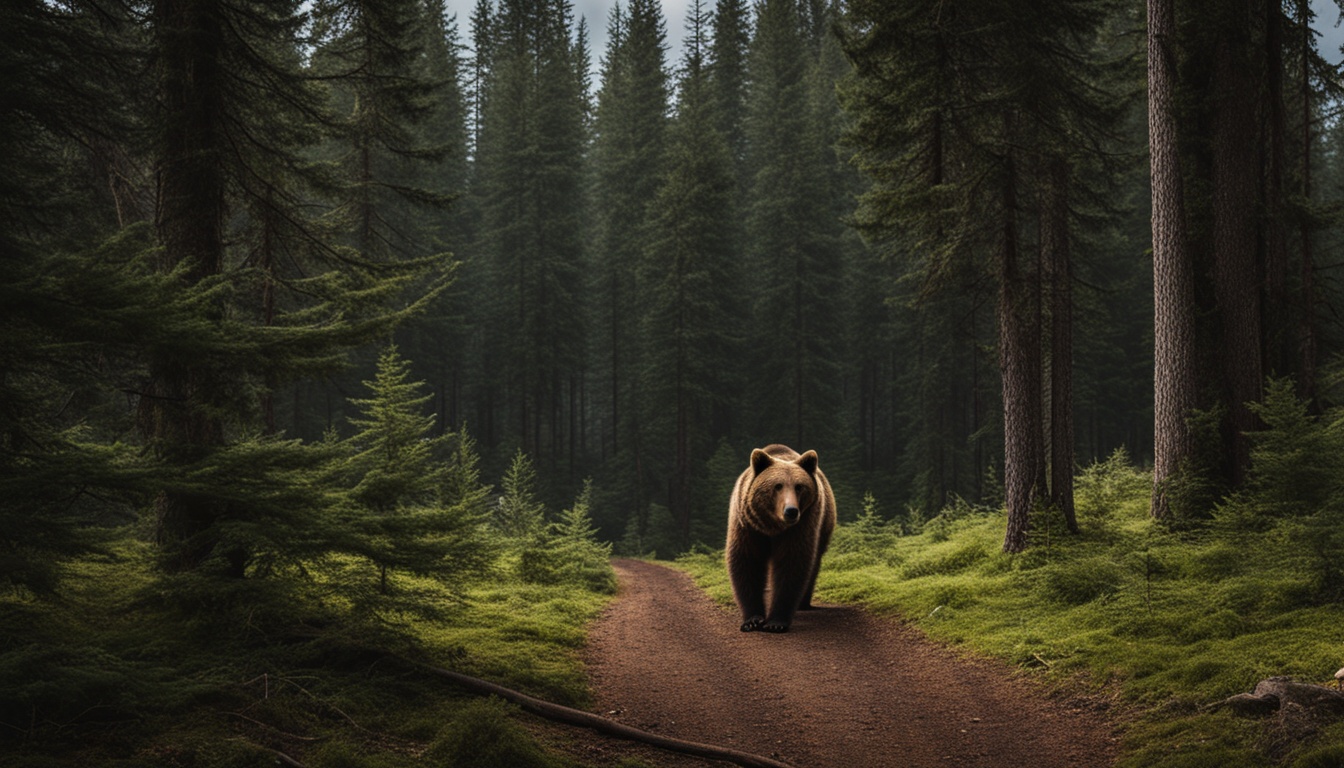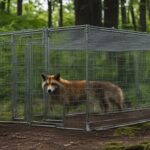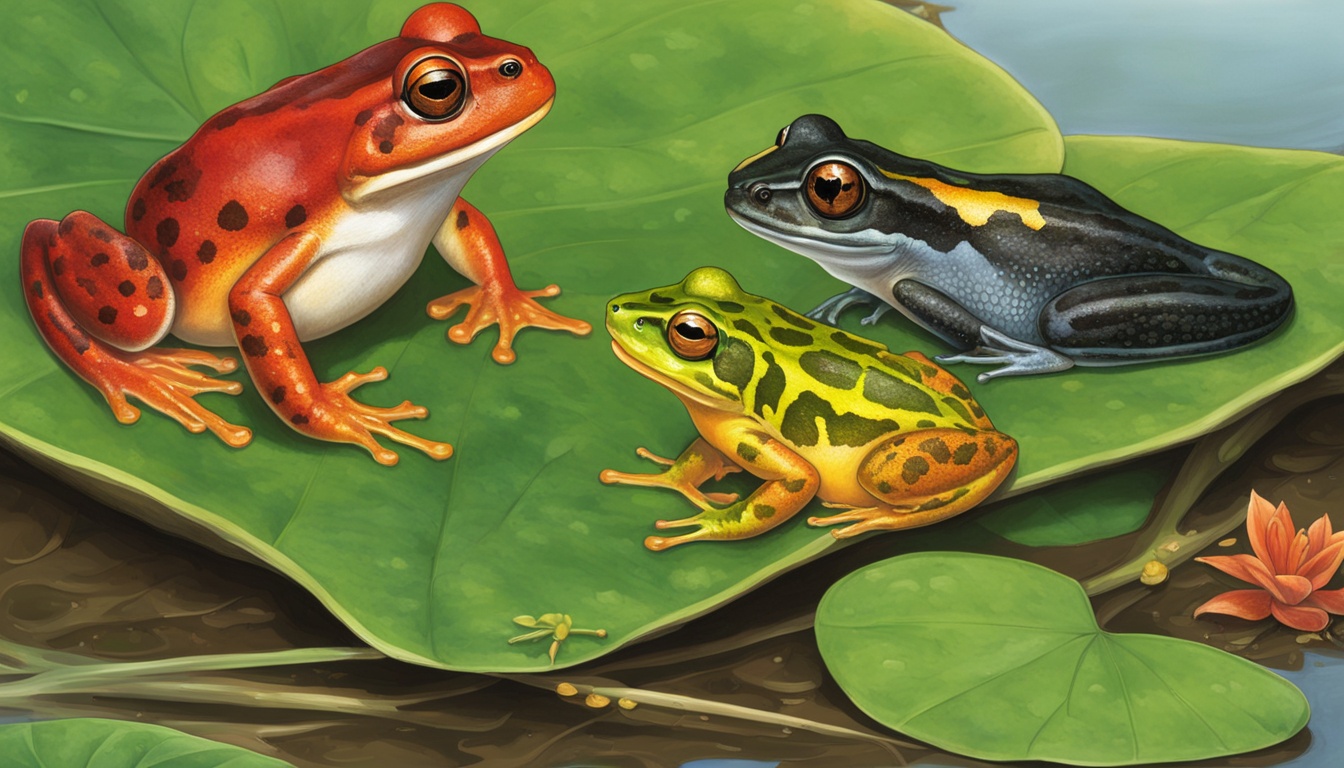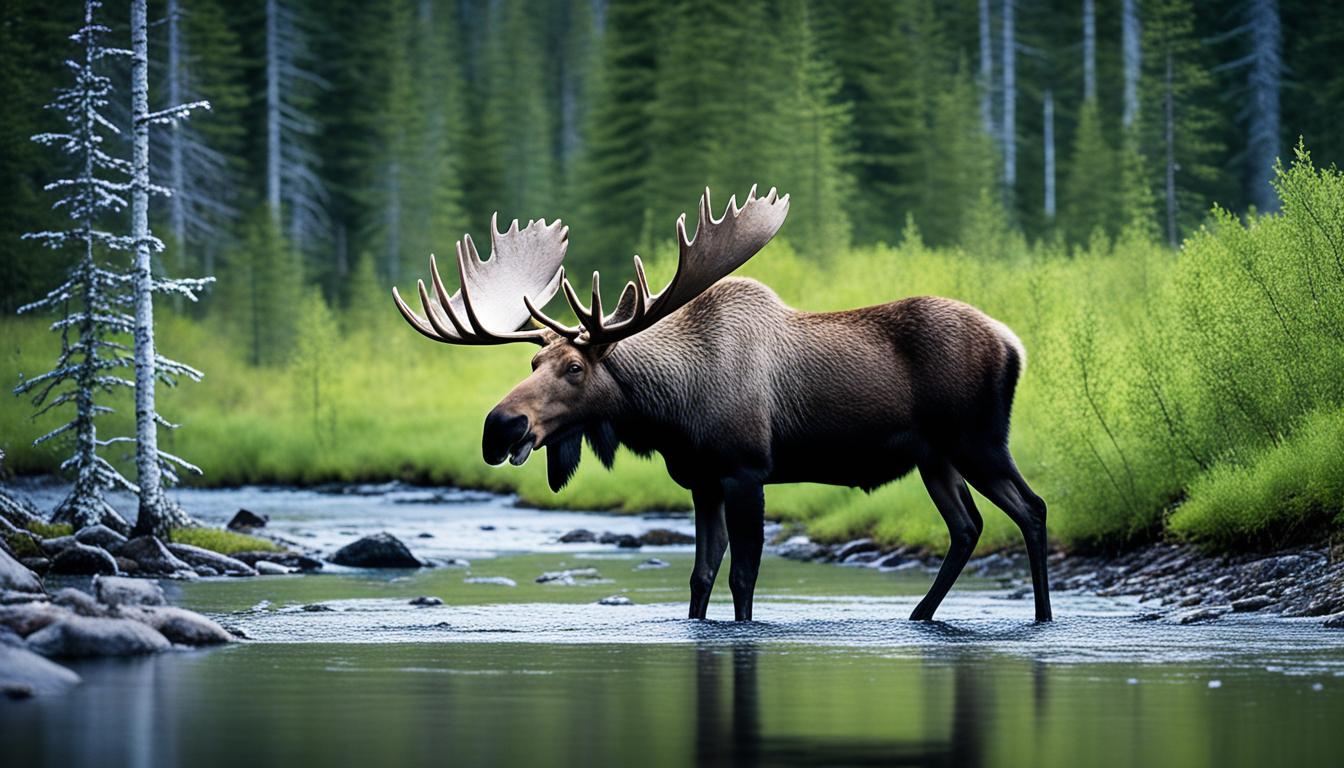Imagine walking in a peaceful forest and meeting a bear suddenly. You might feel excited and scared at the same time. It’s crucial to know what to do for your safety. Understanding the right steps can help you stay safe.
Always keep calm when you see a bear. Don’t run or move suddenly. Try to calm the bear with soft words and slow movements. It’s wise to learn about bear safety from local park centers before you go anywhere. Being in a group and protecting your food lowers the chance of an encounter. Each situation is different, but these tips can make you safer.
Understanding Bear Behavior and Identifying Species
Learning about bear behavior and types is key for those going into their habitats. It helps you respect these amazing animals. Also, it’s important for staying safe around bears in the wild.
Grizzly Bears vs. Black Bears
Grizzly bears and black bears look and act differently. Grizzlies have a big hump on their shoulders and less visible ears. But, black bears don’t have a hump and their ears stand out more.
Knowing where they live helps too. Grizzlies like open, mountainous areas. In contrast, black bears choose forested places.
| Feature | Grizzly Bears | Black Bears |
|---|---|---|
| Shoulder Hump | Present | Absent |
| Ear Prominence | Less Prominent | More Prominent |
| Typical Habitat | Open, Mountainous | Forested |
Bear Behavior Traits
It’s vital to understand bear behaviors during your outdoor trips. Bears show many signs to express how they feel. A bear on its hind legs mostly means it’s curious, not aggressive. Yet, actions like woofing, snapping jaws, and ears laid back show they might be upset or stressed.
Knowing these signs is important for your safety. Understanding animal behavior helps you react well to bears, avoiding dangerous situations. Although bears might act tough with charges, they’re often just trying to scare you off without really wanting to harm you.
Essential Bear Safety Tips for Hikers and Campers
For those heading into bear territory, it’s key to follow important safety steps. Knowing how to hike safely and camp responsibly matters a lot. It helps keep you safe and the bears safe too.
Traveling in Groups
Walking in groups is a top bear safety rule. Bears are more afraid of big, loud groups. It means they’re less likely to come near. Always keep your group close, especially where bears hang out. Besides staying safe from bears, group travel means you help each other out if something goes wrong.
Making Noise
Talking, clapping, or shouting are important for staying safe while hiking. It lets bears know you’re there, so they can move off. Using bear bells or noise-makers also helps. They make sure bears hear you all the time, keeping surprises at bay.
Keeping Food Secure
Storing food right is crucial when camping where bears are. Use bear-proof containers or hang food high up. This keeps bears from your camp. Also, keep food and smelly things far from where you sleep. It’s good for your safety and helps the bears keep their distance, sticking to their own food sources.
Avoiding Bear Encounters in the Wild
It’s key to know how to act around wildlife to avoid meeting bears. Keep your distance and watch carefully. Stay away from areas with lots of food, like berry bushes and fish-filled waters. These places attract bears.
Viewing Etiquette
When you watch wildlife, make sure you’re far enough. This keeps you safe and doesn’t upset the animals. Stay quiet to not scare bears. Always think about the animals and keep their home safe by using proper wildlife viewing etiquette.
Recognizing Bear Habitat
Knowing where bears live can help you stay safe. Look out for thick plants, berry patches, and areas near water where fish are. Avoid these places or be really careful if you have to go through them. Stay sharp and show nature the respect it deserves for a great time outdoors.
How to React if You Encounter a Bear
If you see a bear, the first thing to do is stay calm and still. Talk to the bear in a soft voice, showing you’re a person and not food. Don’t make quick movements or loud sounds that might scare the bear. Instead, move your arms slowly to look bigger. Then, slowly step back, keeping your side to the bear. But, never climb a tree to escape. Both grizzly and black bears can climb trees too.
When a bear is standing still, calmly leave the area. Make sure to leave a way for the bear to get away safely. Keep a good distance from the bear for your safety and theirs. Always be mindful of the space around you.
What should you do if you encounter a bear in the USA?
Meeting a bear in the wild can be scary. It’s important to know what to do for your safety and the bear’s. First, let the bear know you’re a human. Stay quiet and calm.
Initial Response
When you see a bear, let it know you’re a human, not food. Keep calm and talk in a low voice. This may keep the bear from getting aggressive. Avoid quick movements and loud sounds. These actions could scare the bear into attacking.
Reading Bear Signals
It’s key to understand a bear’s actions. If a bear stands up, it might just be curious, not ready to attack. But if it growls or snaps its jaw, it’s signaling aggression. You should know what these signs mean. This helps you know whether to step back slowly or stay put.
Dropping your backpack won’t help, and neither will running. Running from a bear can make it want to chase you. If a bear tails you, stand your ground. Slowly find a way around it without causing shock.
Understanding Bluff Charges vs. Aggressive Charges
When bears are near, it’s vital to know the difference between bluff charges and aggressive charges. This knowledge can keep you safe. Bluff charges are common. They are less likely to harm you, aiming more to scare. If you can tell what kind of charge it is, you can choose the right action. This can mean the difference between walking away safely or a risky situation.
Bluff Charges Explained
A bluff charge means a bear quickly moves toward you but then stops or turns away. Seeing a bear with its ears back and head up tells you it might just be a warning. This is your chance. Stay calm, don’t look the bear in the eyes, and talk quietly. Acting non-threatening shows the bear you are not there to harm.
Responding to Aggressive Charges
Aggressive bear encounters are very dangerous. If a bear yawns, clacks its teeth, or huffs, it might be getting ready to charge for real. In these cases, you have to act fast. For a grizzly bear, lay on your stomach, spread your legs, and protect your neck. Playing dead can make the grizzly bear stop. However, if it’s a black bear, you should fight back. Use whatever you can to aim at its face.
| Bear Behavior Analysis | Bluff Charges | Aggressive Charges |
|---|---|---|
| Body Language | Head up, ears back, tense posture | Yawning, clacking teeth, huffing |
| Approach | Charges but stops or veers off | Continues charging with possible attack |
| Response | Stand ground, speak calmly | Play dead (grizzlies), fight back (black bears) |
Using Bear Pepper Spray Effectively
Bear pepper spray is vital for defense against bears. It’s important to choose the right one and know how to use it. This knowledge is critical in bear encounters, potentially saving lives.
Selecting the Right Bear Spray
Choose an EPA-approved bear spray specifically. It should have a minimum 25-foot range and last for 6 seconds. Pick a reliable brand known for bear deterrence.
How to Use Bear Spray
To use bear pepper spray effectively, have it ready to use. This means keeping it in an easy-to-reach place, like on a belt. Be ready to act fast. Aim down and toward the bear. In a charging situation, spray in short bursts. Use bear spray only as a defense, not on gear or yourself as a repellent.
| Attribute | Requirement |
|---|---|
| Approval | EPA-approved |
| Range | Minimum of 25 feet |
| Duration | At least 6 seconds |
| Deployment | Accessible and quick to use |
Being informed and aware of bear safety gear is key. Learning how to use bear spray can boost your confidence in the woods. Always be prepared for safety, especially in bear territory, for a great nature experience.
Steps to Take if a Bear Attacks
If you ever face a bear attack, knowing what to do can help you stay safe. It’s important to understand how to react to grizzly and black bear attacks. This knowledge is key to surviving a bear encounter.
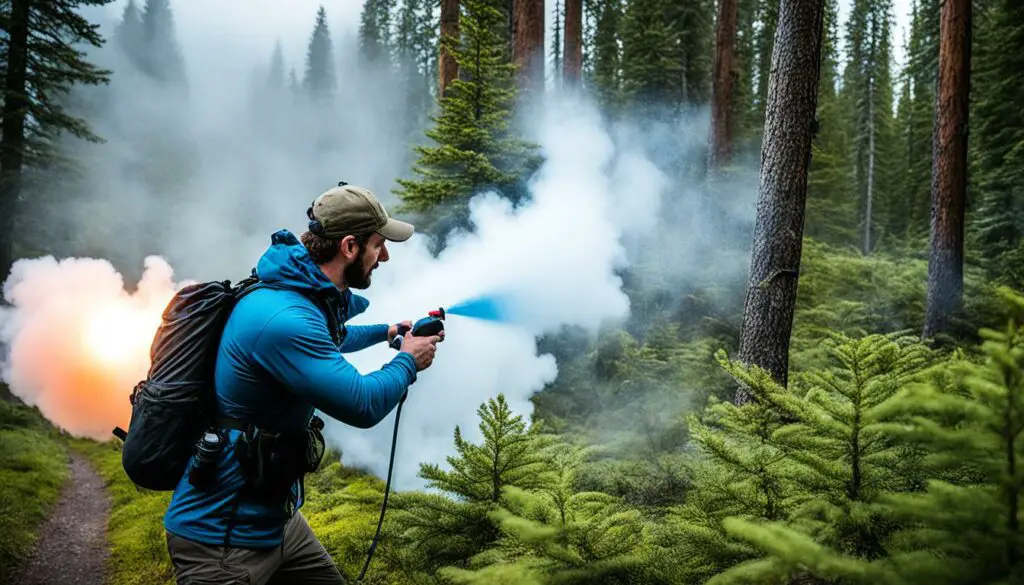
When a Grizzly Bear Attacks
If you encounter a grizzly bear, your best bet is to play dead. Lay on your stomach with legs spread to be difficult to flip. Protect your head by placing your hands around your neck. A backpack can also shield you. If the bear continues, you might have to defend yourself by fighting back.
When a Black Bear Attacks
However, when facing a black bear, don’t pretend to be dead. Instead, try to scare it off or fight back. Hit its face and muzzle if you can. Use tools or anything else to keep the bear away.
Defensive Measures
Use protective measures to better your chances. Bear pepper spray can stop the bear. Also, using nearby items as weapons is smart. Staying calm and using everything you have are important survival tips. No matter the type of bear, quick and smart reactions are crucial for your safety.
| Bear Type | Action | Defensive Measures |
|---|---|---|
| Grizzly Bear | Play dead, switch to fighting if persistence | Bear spray, use objects as weapons |
| Black Bear | Do not play dead, fight back aggressively | Aim for face and muzzle, use bear spray |
Specific Tips for Black Bear Encounters
Whether it starts calm or becomes aggressive, the right actions can keep you safe.
Non-Aggressive Interactions
If a black bear seems calm, stay calm yourself. Stand tall, wave your arms, and speak in a soft voice. This shows the bear you’re not a threat. Often, the bear will just wander off. Handling the interaction with black bears calmly can avoid any danger.
Aggressive Encounters
When a black bear acts aggressive, be strong. Don’t run or act like you’re dead. Instead, get ready to defend yourself. Use whatever you can against the bear. Aim at the bear’s face to stop it from attacking more. By knowing how to act in an aggressive encounter, you can stay safe and protect others. Always tell park officials about these encounters to improve black bear safety.
Specific Tips for Grizzly Bear Encounters
To stay safe around grizzly bears, it’s vital to know how to act in different situations. This means understanding what to do when they’re calm or when they act aggressively. Your actions can make a big difference in dangerous moments.
Non-Aggressive Interactions
If you spot a grizzly but it’s not acting aggressive, keep your distance. Don’t stare them in the eyes as this might come off as a challenge. Talk softly as you back away slowly. Make sure not to show your back to the bear. Doing this helps keep things calm.
Aggressive Encounters
When a grizzly seems ready to attack, it’s key to keep calm and follow a few steps. Never run or try to climb up something. Bears are faster and more agile than you think. If the bear gets too close, get on the ground. Lie face down, hands on your neck, legs spread.
If the bear starts to attack, playing dead might work at first. But if the bear keeps coming after you, you may have to fight back. Use everything you can to protect yourself. These steps are critical in keeping you safe, as advised in important bear confrontation tips.
Being prepared and knowing how to react is essential for grizzly bear safety. Always remember that these animals are incredibly strong and their actions can be hard to predict. Respecting their space helps us all live more safely in nature.
| Non-Aggressive Encounters | Aggressive Encounters |
|---|---|
| Maintain distance, speak calmly, avoid eye contact. | Do not run or climb, play dead if attacked, fight back if persists. |
Handling Encounters with Predatory Bears
Meeting a bear in the wild is scary. But, it’s key to know if a bear is predatory. Understanding this can keep you safe. Predatory bears give off clear signs. These signs tell you they view you as prey. Knowing how to react could be a lifesaver.
Signs of Predatory Behavior
Predatory bears act in ways that show they may attack. Signs include:
- Stalking or following you over a distance
- Showing undue curiosity by making eye contact or circling
- Displaying a determined approach without backing down
Seeing these signs early helps you plan your safety tactics.
How to Respond
Facing an aggressive bear calls for a calm and thoughtful reaction. Running will make things worse. Instead:
- Seek shelter behind something solid like a tree or boulder.
- Prepare to defend. If you have bear spray, use it aiming for the face.
- Fight back as vigorously as you can. Target the bear’s face and muzzle.
Always inform park rangers about aggressive encounters. They will take steps to protect others in bear areas.
| Signs of Predatory Behavior | Response Actions |
|---|---|
| Stalking or Following | Seek shelter, prep for defense |
| Undue Curiosity | Do not run, ready your bear spray |
| Steady Approaching | Fight back, target the face/muzzle |
Reporting Bear Encounters
Meeting a bear in the wild can be exciting yet dangerous. It’s key to report the event responsibly. Touching base with local park officials is important. This is how they’ll keep track of bear movements and prevent future problems. If the bear showed aggression or attacked, call 911 immediately for help.
Sharing details about your bear encounter helps everyone visiting the park. Accurate reports let park staff track bear behavior. This helps them spot dangerous spots and create ways to keep people safe. It also protects bears by avoiding harmful run-ins with humans.
When reporting a bear encounter, include details like the bear’s actions and what you did. Also, mention where and when it happened. If you have photos or videos, share them with rangers. This will help them grasp the situation better. Contributing to these reports aids in making the wilderness safe for both people and bears.

